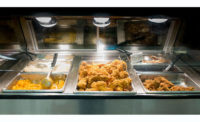Meat and poultry, which traditionally have been powerful supermarket deli magnets, are becoming less forceful.
Deli meats sales were flat in 2014, with a volume increase of 1.1 percent, reports the Nielsen Perishables Group, a Chicago-based fresh foods consulting and research firm. Meats, which comprise 20.7 percent of deli revenues, trail the 2014 overall deli growth of 5.7 percent in volume and 7.4 percent in dollars.
Hampering expansion opportunities is a saturated market in which 96 percent of consumers report their households already purchase lunch meats, resulting in little space for new shoppers beyond population growth, according to Mintel Group Ltd., a Chicago-based market research firm.
To ignite sales, deli merchandisers will need to leverage new products and offer new uses for meats, analysts say.
“We haven’t seen much merchandising innovation within the deli meat category in recent years,” says Sarah Schmansky, Nielsen Perishables Group director of account services. “A few new meat varieties have made their way into the service case, such as bacon, and specialty meat continues to define its space within the specialty cheese section. But overall, there are no real merchandising changes.”
Bulk items remain the major deli meat revenue generator, accounting for 83.5 percent of meat sales for the 52 weeks ended Dec. 27, 2014. Next were pre-sliced meats (12.6 percent) and specialty meats (4 percent).
Dollar share for turkey and ham, which account for 35 percent and 31 percent of deli meat sales, respectively, has held steady since 2010, she says.
Deli meat revenues, bolstered by rising protein prices, rose 6 percent last year. Specialty meats such as sausage, pepperoni and chorizo had the largest increase (10.8 percent), followed by pre-sliced (6.5 percent) and bulk (5.7 percent).
Contributing to stronger specialty meat activity is an increase in snacking by Millennials and greater interest in using specific proteins as ingredients, such as on pizza, Schmansky says.
To spark more activity by current buyers, Mintel suggests highlighting additional uses for lunch meats beyond traditional sandwiches, such as for snacks, entertaining and as ingredients in various recipes.
Eighteen percent of all consumers (as well as almost a third of 18- to 24-year-olds) who eat lunch meat say they would consume more if they had additional ideas on how to use the proteins, Mintel notes.
Meat brands can play a major role in generating such interest, the firm states.
“Because consumers are already familiar with and trust the lunch meat brands, they will be more willing to try a new product by the same company, despite its positioning for new uses,” Mintel says.
Retailers, meanwhile, can educate shoppers on new meat products and recipes via such vehicles as sample tables in delis, data on packages and the use of quick response (QR) codes on displays and products, Mintel adds. Consumers with mobile devices can scan the codes and, for instance, link to a brand’s website which might offer short video demonstrations on how to prepare different dishes with lunch meat.
In addition to spotlighting new uses of meat, deli operators also can benefit by offering more health-oriented proteins.
Mintel research found that 20 percent of consumers age 18 and over say prepackaged lunch meat is too processed for their tastes, and 45 percent say all-natural ingredients are important to their purchase decision.
In addition, more than a quarter of lunch meat users cite products with low or no fillers, low or no nitrates and nitrites, and being free of hormones as purchasing priorities.
“Lunch meat brands should introduce new products or product lines with completely new packaging and positioning as the natural, good-for-you and safe lunch meat option,” Mintel states. “Product packaging can also explain where the meat comes from in order to reassure consumers.”
There are ample opportunities for deli operators to add lines of health-oriented proteins as 90 percent of the deli meats sold have no declared health benefits, Schmansky says.
Of the items with health declarations, reduced-fat products generate the most activity, accounting for 3 percent of overall deli meat sales. They are followed by products with low or no salt (2.8 percent), reduced sodium (2.3 percent), and “lean” or “light” in their names (0.6 percent).
Products labeled as “healthy” generated the largest dollar sales growth (59.2 percent) in 2014 among deli meats with a health declaration, Nielsen Perishables Group reports. Revenue growth also was strong for meats with no saturated or trans fats (28.1), lean or light meats (14.9 percent) and reduced-fat products (6.4 percent).
“Consumers are reading labels,” says Jonathan Whalley, education coordinator for the Madison, Wis.-based International Dairy-Deli-Bakery Association (IDDBA). “Preservatives and sweeteners get the attention of some label readers, while others focus on attributes such as grass-fed, organic and natural.”
Specialty meats, he notes, also are set to become more prominent as greater numbers of consumers seek higher-quality items.
“Merchandising the rich culture of Italian meats could be more beneficial than simply offering a price point of something many consider to be an indulgence,” Whalley says.
Shoppers, he says, are becoming familiar with different varieties of cured meat via restaurant menus and television food programs and are increasingly seeking the proteins in delis.
“The items offer exotic flavors for a unique experience,” he says. “Standard products like beef, ham and turkey are meeting popular flavor trends like bacon, Sriracha and fresh herbs.”
The strongest interest in specialty meats is being generated by Millennials, with married shoppers with no children triggering the most activity, the IDDBA notes.
The most frequent purchasers of bulk deli meats, meanwhile, are higher-income households and larger families with children 13 years of age and older, Schmansky says. The largest segments of pre-sliced deli meat buyers are persons 45 years of age or older, along with higher-income and smaller households.
“The biggest opportunity for retailers is to emphasize the basic staples that consumers are always in need of, such as turkey, ham, salami and beef, and then pepper in the new and exciting flavors and varieties of deli meats on a regular cadence to remain enticing to shoppers,” she says. “They include flavors that are currently growing, including barbecue, smoked, apple smoked, honey, chipotle, oven roasted and garlic.”
The merchandising of all service case meats, meanwhile, is likely to become more challenging if, as some analysts predict, the growing popularity of prepared items results in the expansion of hot and cold food stations within the deli, leading to a subsequent contraction of meat displays.
“Deli-prepared has been the focus over the last few years and it’s taking up more and more real estate,” Schmansky says.
She adds that while prepared foods are a great option for consumers who may be lacking culinary experience or don’t have the time or money to eat at a restaurant, “it poses a real challenge to deli meat. How can meat continue to remain a player and not lose space within the store?”
The expanding interest in deli-prepared foods, however, is triggering the merchandising of broader arrays of proteins.
Many Whole Foods Market Inc. locations, for instance, have separate stations for protein-based selections, including barbecue, burgers, tacos and sandwiches.
In addition, prepared entrées in service cases have included Chicken Tikka Masala, Apricot Chicken Tagine, Beef Lasagna, Turkey Picadillo and Meatballs with Marinara.
More retailers, meanwhile, are positioning the deli as a meal destination and seeking to compete with foodservice locations for share of stomach.
“Many leading supermarkets have realized that their shoppers are considering alternatives for food purchases, including restaurants, perimeter prepared foods and subscription meal services,” says Wade Hanson, principal at Technomic Inc., a Chicago-based food and foodservice research and consulting firm. “Differentiation of the perimeter requires significant commitment and must appeal to the needs of the shopper. Therefore, things such as made-to-order proteins, in-store grill service and the use of fresh protein in authentic, ethnic prepared foods are essential.”
Delis, he notes, are becoming more innovative and merchandising items that many operators wouldn’t have considered just a few years ago, such as Korean fried chicken and barbecue from in-store stations.
It is a trend that will become increasingly prevalent and have a stronger impact on deli operations, he says.
“Demand for prepared foods will continue to rise,” Hanson says. “Delis will have to re-think their operations as some departments will reach the point where prepared foods make up 75 percent of deli sales.”
Prepared foods in 2014 generated 57.1 percent of deli revenues, Nielsen Perishables Group reports. They were followed by meats (20.7 percent), cheese (17.8 percent), beverages (4.1 percent) and other items (0.3 percent).
Bulk meats, however, were the largest single contributor to deli revenues, accounting for 17.3 percent. Next were prepared chicken (16.1 percent) and specialty cheese (11.6 percent).
Among other deli contributors were sandwiches, generating 6.1 percent of revenues, sushi (2.8 percent) and pre-sliced meats (2.6 percent).
“There are a lot of new flavorful and innovative deli-prepared products and meal solutions,” Schmansky says. “Many retailers also are using deli sandwiches to create a go-to destination in the prepared section by focusing on premium and specialty items and often attract consumers who make a separate trip to the deli for the sandwiches.”
But to maximize revenues from prepared proteins, deli operators will need to enhance product quality and take steps to draw more shoppers on a regular basis.
In a 2013 consumer study by Datassential, a Chicago-based food research firm, 53 percent of respondents noted that they perceive supermarket prepared foods to be either “excellent” or “good.”
While the figure exceeds that of quick service restaurants (49 percent), supermarkets still trail other prepared food competitors, family-style restaurants (66 percent), fast casual restaurants (70 percent), casual locations (79 percent) and fine-dining restaurants (89 percent).
In addition, the study found that 70 percent of consumers say they either always or occasionally visit the deli during each shopping trip, but just 62 percent and 61 percent, respectively, state they always or occasionally shop the cold prepared and hot prepared food areas.
“That is a transformation to make the traditional deli appear more like a restaurant,” says Jack Li, Datassential managing director. “The big challenge is to offer an experience that is so great that it will drive shoppers to the store.”
It is key, he notes, to offer protein recipes that differentiate the prepared deli from competitors while also offering items that are popular at local restaurants.
A supermarket situated near a Kentucky Fried Chicken outlet, for instance, could offer unique chicken varieties in the deli, such as stuffed chicken wings, Li says.
“There is tremendous growth in prepared and grab-and-go foods in delis,” adds David Donnan, a partner at A.T. Kearney, a Chicago-based global strategy and management consulting firm. “The challenge is primarily for operators to treat the deli like a restaurant and not a deli. It requires a change in mindset and a very different way of approaching the deli counter.”
Such approaches can include developing signature deli items to drive traffic, such as meat loaf or wraps, and offering wide arrays of selections in which meats are positioned as entrées and ingredients, he says.
Delis, Donnan adds, already have an advantage over many foodservice outlets because numerous shoppers associate supermarket perimeter departments with freshness.
“Having organic and locally grown foods are big grocery store attributes,” he says. “They are very positive features for merchandising meats.”
Yet, while many deli operators are positioning prepared foods as the major revenue generators, it is important that they don’t give short shrift to the traditional meats, Schmansky notes.
“Deli-prepared is getting the lion’s share of attention, but consumers still want to get the staples,” she says. “Retailers need to make sure they have the turkey, ham and salami basics, as well as seasonal and bold flavors and new items to keep it exciting and relevant for shoppers and to keep them coming back.”
An evolving deli requires operators to adapt a new set of merchandising methods. Proteins, however, will remain center stage and are the key vehicles for luring and captivating consumers. NP












Report Abusive Comment